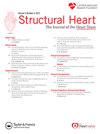Patent Foramen Ovale Closure in Older Patients With Cryptogenic Stroke: Current Evidence and Next Steps
IF 2.8
Q3 CARDIAC & CARDIOVASCULAR SYSTEMS
引用次数: 0
Abstract
Stroke is a major cause of morbidity and mortality worldwide, with recurrence risk increasing with age. In patients over 60 years of age with cryptogenic stroke, paradoxical embolism through a patent foramen ovale may be an important pathophysiology contributor, particularly when high-risk anatomical features (e.g., large shunt, atrial septal aneurysm) are present. Although patent foramen ovale closure has become a standard therapy in younger cryptogenic stroke patients, its benefit in older adults remains uncertain due to limited evidence and the need to exclude highly prevalent alternative causes like atrial fibrillation or carotid disease. A multidisciplinary heart-brain team is critical for accurate diagnosis, patient selection, and shared decision-making. Current guidelines vary and highlight the need for more robust data in this population. Recent observational studies suggest that patent foramen ovale closure in older patients may be safe and potentially reduce stroke recurrence compared to antithrombotic therapy alone. Ongoing randomized controlled trials are expected to provide definitive evidence on the efficacy and safety of patent foramen ovale closure in this age group, guiding future clinical decisions.
老年隐源性卒中患者卵圆孔未闭:目前的证据和下一步
中风是世界范围内发病率和死亡率的主要原因,其复发风险随着年龄的增长而增加。在60岁以上的隐源性卒中患者中,通过卵圆孔未闭的矛盾栓塞可能是一个重要的病理生理因素,特别是当存在高风险解剖特征(如大分流、房间隔动脉瘤)时。尽管卵圆孔未闭已成为年轻隐源性卒中患者的标准治疗方法,但由于证据有限,且需要排除房颤或颈动脉疾病等高度流行的其他原因,其在老年人中的益处仍不确定。一个多学科的心脑团队对于准确诊断、患者选择和共同决策至关重要。目前的指南各不相同,并强调需要在这一人群中获得更可靠的数据。最近的观察性研究表明,与单独抗血栓治疗相比,老年患者卵圆孔未闭闭合可能是安全的,并有可能减少卒中复发。正在进行的随机对照试验有望为该年龄组卵圆孔未闭闭合的有效性和安全性提供明确的证据,指导未来的临床决策。
本文章由计算机程序翻译,如有差异,请以英文原文为准。
求助全文
约1分钟内获得全文
求助全文
来源期刊

Structural Heart
Medicine-Cardiology and Cardiovascular Medicine
CiteScore
1.60
自引率
0.00%
发文量
81
 求助内容:
求助内容: 应助结果提醒方式:
应助结果提醒方式:


